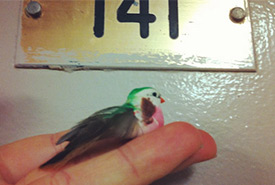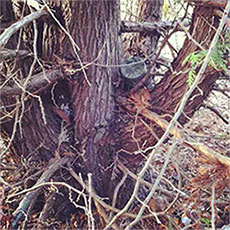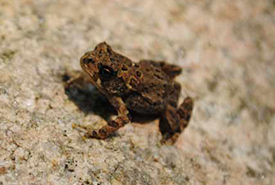Found it!

Our geocaching team: 141girls, named after our dorm room number. (Photo by Raechel Bonomo/ NCC staff)
Saturday August 15 is International Geocaching Day! Geocaching is a worldwide treasure hunt, with caches (or treasure chests) ranging from micro to macro in size hidden throughout various terrains outdoors. The caches are found by using GPS co-ordinates and sometimes hints or clues set out by fellow cachers. Geocaching originated on May 3, 2000 with the first cache placed by Dave Ulmer in Beavercreek, Oregon. There are now more than two million caches across the world!
Geocaching is meant for all experience levels. Whether you’re a seasoned bushwhacker or the occasional hiker, you’re bound to come across a cache.
It’s super easy to get started too!
I first heard of geocaching in a geospatial lecture at Fleming College in Lindsay, Ontario. My professor described ways a GPS was used recreationally and how this international craze of geocaching was both fun and a great way to enjoy nature. I was immediately intrigued. I started to research and found out all I needed to know to get started on the official geocaching website.
I rounded up my roommates and we became the geocaching team "141girls," named after our dorm room number.
I recommend starting your geocache adventure with a group. Although you don’t need a team to geocache, it’s easier to start with many sets of eyes searching and more fun seeing who the first to find the cache is!
You also don’t need a GPS to geocache. You can use your smartphone by downloading the app and using data while out searching! Once you’ve done that you’re ready to go. The great thing about geocaching is you don’t have to go far to find treasure! There are caches everywhere. From rural to urban areas, by using the app you can pinpoint where they are hidden and how many caches are in that area.
Geocaching can be done all year round but for first-timers and less experienced cachers, late spring and summer are the best times to hunt for caches. In fall and winter, foliage from trees and weather conditions such as snow can impact the visibility of an already camouflaged cache. Winter can also bring on additional safety concerns and can make areas slippery.
It is important to note there are hazards of geocaching in any season. When navigating, make sure to avoid walking while looking down at your compass or smartphone. Some caches are hidden in rocky areas, physically challenging terrains or in areas with water. It’s important to keep an eye for yourself, any team members and for the cache!
Here’s what I recommend you (or a team member) bring in a small backpack during geocaching:
- enough water for you/each member of your team;
- bug spray (especially if caching in a dense forest area);
- tiny trinkets for trading;
- a few pens/pencils (I prefer small golf pencils in case you need to leave one behind for caches with logs); and
- sunscreen.

A geocache. Caches range from small (or micro) to extra-large (macro). (Photo by Raechel Bonomo/ NCC staff)
Now, you’re probably thinking, "Trinkets, logs?!" Well this part will make more sense once you find a cache. Often people who leave caches will leave a log or journal for finders to sign with their name and date found. As for trinkets, caches usually hold an assortment of knick-knacks for cachers to trade depending on the size of the cache itself. Caches range from small to extra-large. The size of the cache will be indicated with the hint and GPS coordinates so you know what to look for!

Pickerel frog (Photo by Raechel Bonomo/ NCC staff)
Geocaching isn’t just about finding a cache. It’s about the adventure of searching for it! Often caches are concealed in beautiful habitats shared with different members of the environment. From dense forest areas to ponds and creeks, caches bring people to various parts of the land.
Caches are often hidden in gaps in rocks or between branches. By looking in each crevice within a cache’s vicinity, I begin to gain a different perspective on nature. Instead of looking at the big picture, I begin to notice and appreciate the details hidden within the landscapes. I may discover a unique species of fungi or a small creature, camouflaged in foliage. On my last geocaching trip, I ran into this baby leopard frog (left) just a metre away from a cache.
You can also combine geocaching with almost any outdoor activity, such as kayaking, hiking or camping! It’s great for friends, families or individuals of all ages and experience who want to get out and explore an area. If ever I am in need of a quick-nature break, I open my geocaching app to find the closest cache near me and hunt away!
Since that day four years ago when I found my first cache, yelling "Found it!" is still just as exciting.


